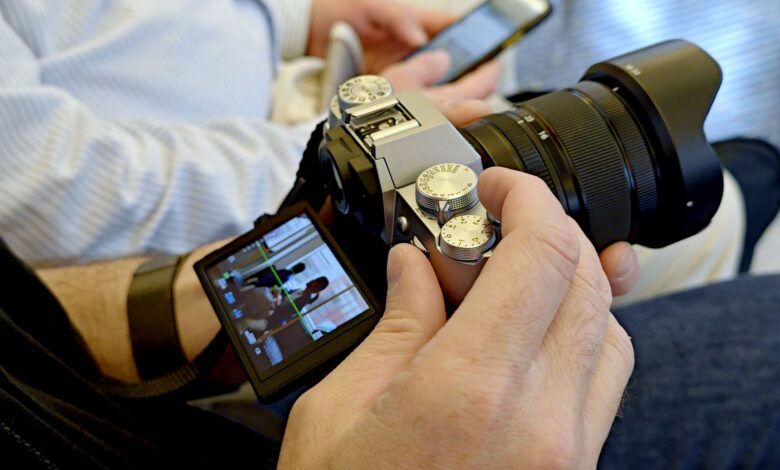Fujifilm X-T50 review: A big improvement (for a lot more money)

Fujifilm’s X-T30 II is one of my favorite cameras, as it offers many of the capabilities of the higher-end models for a lot less money. So I was particularly excited when the company launched the X-T50, which is like a miniature version of the $1,700 X-T5.
It shares many features, including a 40.2-megapixel sensor, 6K 30P video support and, in a first for the series, in-body stabilization. At the same time, it retains the small size and retro-cute styling of past models.
At $1,400 it’s not nearly as affordable as the $900 X-T30, though. To find out if it’s worth an extra half grand, I tested the X-T50 out in London with some professional photographer friends.
Body and handling
The X-T50 is all about portability and style, so it’s nice and light at 438 grams (0.96 pounds), just 50 grams more than the previous model. If you’re traveling with a compact lens, it can easily be slipped into a bag.
At the same time, the grip has been enlarged enough to make the camera easier to hang on to. Operation is largely unchanged, with two control dials, a shutter speed dial and an exposure compensation dial, along with a joystick and eight buttons. However, Fujifilm did introduce one new trick: a film simulation dial in place of the previous drive mode — more on that shortly.
All of that makes it nearly as easy to control as much larger cameras. The dedicated shutter dial is an unusual feature these days, so it does take some getting used to. The advantage is that you can see that setting just by looking down at the camera, a must for discreet street or travel shooting.
Like past models in this series, the X-T50 has a tilt-only display that doesn’t flip out, which is likely a bummer for the vloggers it’s tantalizing with its video capabilities. And rival models like the Sony A6700 and Canon R7 do have flip-out displays. The 2.36-million-dot electronic viewfinder isn’t super sharp, but is par for the course in this price range.
With a smallish battery like the one on the X100 VI, the X-T50 can manage just 305 shots on a charge or 390 in economy mode. That’s near the bottom in its category. By comparison, Canon’s like-priced R7 can take up to 660 photos before the battery dies.
The X-T50 has a decent array of ports, including microHDMI, USB-C and a mic jack. As before, there’s no headphone input, but you can use the USB-C slot with a 3.5mm adapter to monitor audio. It comes with a single, but fast UHS-II card slot.
Performance
If it’s pure performance you’re after, the X-T50 probably isn’t for you. Burst speeds are decent at up to 13 fps in electronic shutter mode or 8 fps with the mechanical shutter — far from the 30 fps of the Canon R7 in electronic mode. Also, the electronic shutter is only good if your subject doesn’t move too quickly, as rolling shutter distortion is very noticeable in this model.
Autofocus still isn’t a Fujifilm strong point, either. When I was shooting quick-moving subjects, it was a bit hit or miss in continuous mode, particularly when they were close to the camera. However, performance depends greatly on the lens being used.
On top of face and eye detection, Fujifilm has added subject-tracking autofocus modes for animals, birds, cars, motorcycles, airplanes and trains. This feature is completely separate from the regular eye and face detection modes, so you have to dive into the menus to switch between them, or program two separate buttons.
For the other types of photography it’s designed for, the X-T50’s autofocus works well, though it isn’t quite up to Sony, Canon or even Nikon’s standards.
A key new feature is in-body stabilization. With up to seven stops of shake reduction, you can get sharp photos down to about a quarter second. That’s the same as the 557-gram X-T5, which is quite an accomplishment given the size difference. It makes the X-T50 far more versatile, letting you blur motion to create interesting shots or shoot in dark environments.
Image quality
With the same 40MP sensor as the X-H2 and X-T5, the X-T50 offers a major boost in resolution over the 26MP X-30 II. On top of boosting sharpness, the extra pixels make it possible to crop in, something that’s handy for travel photography, wildlife shooting or anything else where you might not be able to get close to the subject.
In-camera treatment of JPEG files is handled well, with pleasant, accurate colors and just the right amount of sharpening and noise reduction. You can often share photos straight out of the camera, with no need for any post-processing — an advantage for street and other photographers who don’t like to mess around in post.
The 14-bit RAW photos offer plenty of room for fine-tuning, as they retain high amounts of detail in highlights and shadows. As such, I saw low levels of banding, noise and other artifacts at low ISOs in all image areas.
The higher resolution doesn’t hurt image quality much in low light, either. Noise is controlled well up to ISO 6,400, and you can go up to ISO 12,800 in a pinch. Considering that the X-T50 is an APS-C and not a full-frame camera, I was impressed with the lack of noise when shooting in bars and other dim environments.
And of course, the X100 VI offers Fujifilm’s full array of film simulation modes, and they’re easily accessible on the new dial. You can experiment with popular looks like Velvia, Eterna, Acros black and white and others. It also comes with Fujifilm’s new Reala Ace, based on one of the company’s old negative films. At the same time, you get a RAW backup in full color, so you’re not locked into a specific look.
Video
With excellent video specs, the X-T50 is a solid hybrid camera, as long as you keep in mind some caveats — particularly around cropping and sharpness.
Much like the X-T5, you can shoot 6.2K at 30 fps with a 1.23x crop, or 4K at up to 60 fps with line-skipping and a 1.14x crop. The cropping occurs because 6K video only requires 24 megapixels, and the sensor/processor combination isn’t up to the job of supersampling the entire sensor width.
The camera also offers sub-sampled 4K at up to 30p using the full sensor width, or high-quality 4K 30p with a 1.23x crop. For super slow-motion, Fujifilm also introduced 10-bit and F-Log2 settings for extra dynamic range.
At 6.2K and 4K HQ, rolling shutter skewing is pronounced so you’ll want to avoid excessive or sharp camera movements. Sub-sampled 4K is better in that area, but video is noticeably less sharp.
Video autofocus matches what I saw with photos, meaning it was decent but not ideal for moving subjects. The AI-powered AF did lock onto subjects, but again, couldn’t always keep up with birds, animals or vehicles.
Handheld video is now a realistic option with in-body stabilization. It works well if you don’t make abrupt movements, and the “boost” mode offers near tripod-like smoothness. Digital stabilization is also available, but isn’t supported with the 6K or HQ modes, and doesn’t reduce jolts when walking.
Video quality is solid for such a small camera, offering the same accurate colors I saw in photo modes. Shooting in 10-bit F-Log made it possible to adjust footage considerably in post or get creative. You can also shoot video using the film simulation modes if you want a specific look straight out of the camera.
Wrap-up
All told, the X-T50 is an awesome upgrade to the X-T30 II, with improvements in nearly every area — particularly resolution, stabilization and video. The film simulation button is a bit gimmicky, but it should appeal to fans of the brand, particularly those who love the X100 VI.
The problem I have with this camera is the price. The $900 X-T30 II was easy to recommend to buyers on a mid-level budget. However, at $1,400, the X-T50 is only $300 less than the superior X-T5, and at that price it has lots of stiff competition from the likes of the Canon R7 and Sony A6700, along with full-frame models like the Canon R8, Nikon Z6 II/Z5/Zfc and Panasonic S9.
Fujifilm likely figured that the X-T50 was nearly as capable as the X-T5 and that the 40-megapixel resolution beats out rivals — but it has priced a lot of potential buyers out of the market. If you’re looking for something that costs around the same as the X-T30 II, Nikon’s $1,100 Zfc is just as pretty and a lot less expensive.
This article originally appeared on Engadget at https://www.engadget.com/cameras/fujifilm-x-t50-review-a-big-improvement-for-a-lot-more-money-180046809.html?src=rss

